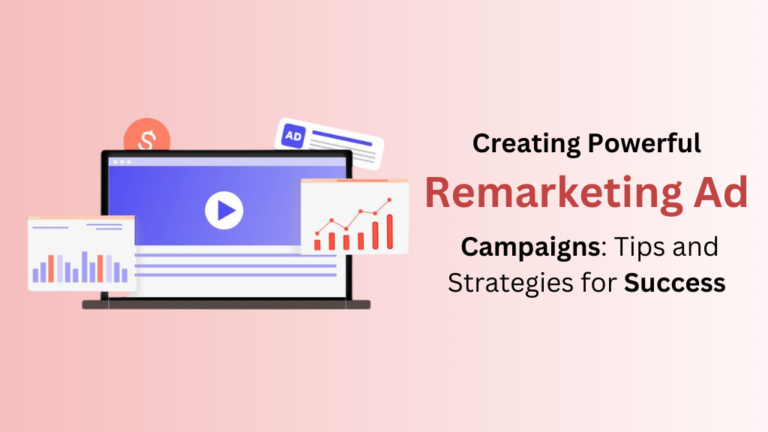In the ever-evolving world of digital marketing, staying ahead of the competition requires a robust and strategic approach. One of the most effective strategies in a marketer’s toolkit is remarketing, a technique that targets users who have previously interacted with your brand. Remarketing helps re-engage potential customers, increase brand recall, and ultimately drive conversions. In this blog, we will explore how to create effective remarketing ad campaigns, leveraging key digital marketing strategies to maximise their impact.
What is Remarketing?
Remarketing, also known as retargeting, involves displaying ads to users who have visited your website or engaged with your content but didn’t convert. These users have already shown interest in your products or services, making them more likely to respond to your ads compared to first-time visitors.
Key Benefits of Remarketing
Increased Conversion Rates: By targeting users who are already familiar with your brand, remarketing ads can significantly boost conversion rates.
Enhanced Brand Recall: Regular exposure to your ads helps reinforce brand awareness, keeping your business top-of-mind for potential customers.
Cost-Effectiveness: Remarketing allows you to focus your budget on users who are more likely to convert, making it a cost-effective advertising strategy.
Personalised Advertising: You can create tailored ads based on users’ previous interactions, making your marketing efforts more personalised and relevant.
Steps to Create Effective Remarketing Ad Campaigns
1. Define Your Goals
Before diving into creating ads, it’s essential to outline your campaign objectives. Are you aiming to increase sales, generate leads, or boost brand awareness? Clear goals will guide your strategy and help measure success.
2. Segment Your Audience
Not all visitors to your website are the same. Segmenting your audience allows you to create more personalised and effective ads. Common segments include:
Site Visitors: Users who have visited your website but haven’t made a purchase.
Cart Abandoners: Users who added items to their cart but didn’t complete the checkout process.
Past Customers: Users who have previously purchased from your site and might be interested in new products or services.
3. Craft Compelling Ad Copy
Your ad copy should be engaging, clear, and concise. Focus on the benefits of your product or service, and use strong calls-to-action (CTAs) to encourage users to take the next step. Highlight any special offers or discounts to entice potential customers.
4. Design Eye-Catching Visuals
Visual appeal is crucial in remarketing ads. Use high-quality images or videos that capture attention and reflect your brand’s identity. Consistent branding helps build recognition and trust.
5. Set Up Frequency Caps
While it’s important to stay visible to your audience, overexposure can lead to ad fatigue. Setting frequency caps ensures your ads are shown to users a reasonable number of times without becoming intrusive.
6. Utilise Dynamic Remarketing
Dynamic remarketing takes personalization a step further by displaying ads featuring specific products or services users viewed on your website. This approach increases relevance and can significantly improve click-through and conversion rates.
7. Optimise Landing Pages
Ensure that the landing pages your ads direct to are optimised for conversions. They should be relevant to the ad content, load quickly, and provide a seamless user experience. A well-designed landing page can make the difference between a bounce and a conversion.
8. Monitor and Analyze Performance
Regularly monitor your campaign performance using analytics tools. Key metrics to track include click-through rates (CTR), conversion rates, and return on investment (ROI). Use this data to identify areas for improvement and refine your strategy.
Want to Get Started on
your Remarketing
journey?
Advanced Strategies for Remarketing Success
1. Leverage Cross-Device Remarketing
Today’s consumers use multiple devices throughout their buyer’s journey. Cross-device remarketing ensures that your ads reach users on desktop, mobile, and tablet, providing a consistent experience across all platforms.
2. Implement Sequential Remarketing
Sequential remarketing involves showing a series of ads to guide users through the conversion funnel. For example, the first ad could introduce your brand, the second highlights a specific product, and the third offers a discount or incentive to purchase.
3. Exclude Converted Users
To maximise efficiency, exclude users who have already converted from your remarketing campaigns. This prevents wasting ad spend on users who have already taken the desired action.
4. Use Lookalike Audiences
Lookalike audiences are users who share similar characteristics with your existing customers. By targeting lookalike audiences, you can expand your reach to potential new customers who are likely to be interested in your products or services.
Common Mistakes to Avoid
1. Ignoring Ad Fatigue
Showing the same ad repeatedly can lead to ad fatigue, causing users to become annoyed and less responsive. Regularly update your ad creatives to keep your audience engaged.
2. Lack of Personalization
Generic ads are less effective than personalised ones. Tailor your ads to different audience segments based on their previous interactions and preferences.
3. Poor Timing
Timing is crucial in remarketing. Displaying ads too soon after a user visits your site may seem pushy, while waiting too long can result in missed opportunities. Experiment with different timing strategies to find the optimal balance.
4. Neglecting Mobile Users
With the increasing use of mobile devices, ensuring your ads are mobile-friendly is essential. Mobile-optimised ads provide a better user experience and can lead to higher engagement and conversions.
Conclusion
Remarketing is a powerful digital marketing strategy that can significantly enhance your advertising efforts. By targeting users who have already shown interest in your brand, you can increase conversion rates, boost brand recall, and achieve a higher return on investment. Implementing the tips and strategies outlined in this blog will help you create effective remarketing ad campaigns that drive results and contribute to your overall digital marketing success.
Remember, the key to successful remarketing lies in understanding your audience, crafting personalised ads, and continuously optimising your campaigns based on performance data. With the right approach, remarketing can become a cornerstone of your digital marketing strategy, helping you stay ahead in the competitive landscape.





